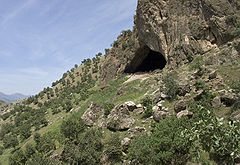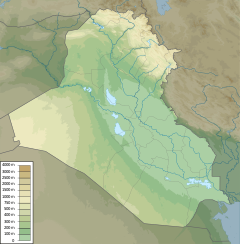Shanidar Cave
| ئەشکەوتی شانەدەر | |

The entrance to Shanidar Cave in the Kurdistan region of Iraq
|
|
| Location | Erbil Governorate, Iraqi Kurdistan, Iraq |
|---|---|
| Region | Zagros Mountains |
| Coordinates | 36°48′02″N 44°14′36″E / 36.8006°N 44.2433°ECoordinates: 36°48′02″N 44°14′36″E / 36.8006°N 44.2433°E |
Shanidar Cave (Kurdish: Şaneder or Zewî Çemî Şaneder; Arabic: كَهَف شانِدَر) is an archaeological site located on Bradost Mountain in the Kurdistan region of Iraq. The remains of ten Neanderthals, dating from 35,000 to 65,000 years ago, have been found within the cave. The cave also contains two later "proto-Neolithic" cemeteries, one of which dates back about 10,600 years and contains 35 individuals.
The best known of the Neanderthals is Shanidar 1, who survived several injuries during his life, possibly due to care from other members of his band, and Shanidar 4, whose body lay beside a flower that can either be explained as evidence of burial rituals or animal contamination.
The site is located within the Zagros Mountains in the Arbil governorate and lies close to the Great Zab river valley.
The ten Neanderthals at the site were found within a Mousterian layer which also contained hundreds of stone tools including points, side-scrapers, and flakes and bones from animals including wild goats and spur-thighed tortoises.
The first nine (Shanidar 1-9) were unearthed between 1957 and 1961 by Ralph Solecki and a team from Columbia University. The skeleton of Shanidar 3 is held at the Smithsonian Institution. The others (Shanidar 1, 2, and 4-8) were kept in Iraq and may have been lost during the 2003 invasion, although casts remain at the Smithsonian. In 2006, while sorting a collection of faunal bones from the site at the Smithsonian, Melinda Zeder discovered leg and foot bones from a tenth Neanderthal, now known as Shanidar 10.
...
Wikipedia

